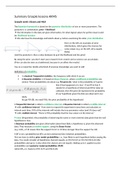Summary
Summary Grasple lessons ARMS
- Course
- Institution
This summary contains all the material from the Grasple lessons provided by the University Utrecht for the course ARMS. It includes material needed for the skills exam (e.g. how to do analyses), but also material for the theory exam. Important concepts are (bold) colored or instructions in italics...
[Show more]



